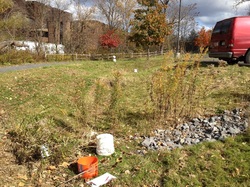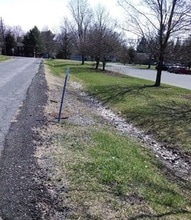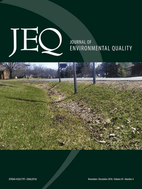Overall aims of my Ph.D. research: assessing water quality function and greenhouse gas emissions in suburban stormwater infrastructure
- Stormwater in suburban areas gets routed into a variety of detention basins, road ditches, and underground infrastructure. While these structures are primarily intended to slow pulses of water to streams and retain sediment and other pollutants, there may be other functions that we don't fully understand. With the changing moisture conditions and influxes of nutrients, these structures may be hotspots for emissions of greenhouse gases such as nitrous oxide and methane, but these same conditions may also promote beneficial water quality services like denitrification, which transforms soluble nitrate into nitrogen gas.
- I combined lab and field observations of these processes so that we can better understand the impact of these structures, and how we might better manage stormwater to maximize both water quality function and detrimental impacts like greenhouse gas emissions.
 Measuring trace gases at a campus detention basin
Measuring trace gases at a campus detention basin
Research on campus detention basins:
- Since 2012 we have been doing research in detention basins around the Cornell campus to better understand how they're functioning, in terms of improving water quality and greenhouse gas (GHG) emissions.
- An initial project led by undergraduate researchers focused on metal accumulation in the basins. My PhD work has been investigating nutrient cycling processes in several of these basins that have have varying hydrologic conditions as well as soil media compositions. We have measured trace gas fluxes from the soils as well as denitrification. This project involved many undergraduate researchers over the years- Peri Gerson, Brandon Roosenboom, Christine Georgakakos, Breann Liebermann, Andrea Fortman and Rachel Whiteheart.
- Check out my recent paper focusing on how hydrologic conditions influence nutrient cycling in stormwater basins. Spoiler: wet basins have higher methane emissions but also higher denitrification potential!

Research on road ditches:
- From summer 2014 to 2015 we monitored water quality and soil nutrient cycling in road ditches in a developed watershed in Tompkins County, NY.
- Similarly to the detention basins, we took water quality samples during storm events for assessment of nutrients and salt, as well as monitoring greenhouse gas fluxes and denitrification in ditch soils. This project involved undergraduate researchers Liza Johnson, Peri Gerson, Brandon Roosenboom, and Julia Dagum.
- This project has allowed us to assess how road ditches in suburban developments impact downstream water quality, as well as how grassed road ditches influence nutrient uptake and greenhouse gas production.
- You can also check out this recent paper which shows that grassed roadside ditches- if managed well- can be hotspots for nitrogen removal. I also found that lawns were hotspots for greenhouse gas emissions, especially for nitrous oxide, and fertilized lawns were especially high emitters of GHGs.
- Our ditches even made the cover (see below) and made it into a research highlight!

